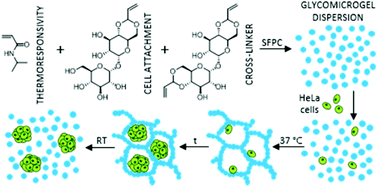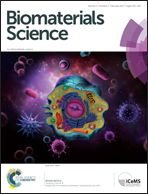Thermoresponsive microgels containing trehalose as soft matrices for 3D cell culture
Abstract
A series of thermoresponsive glycomicrogels with trehalose in the cross-links or with trehalose in the cross-links and as pending moieties was synthesized. These materials were obtained by surfactant-free precipitation copolymerization of N-isopropylacrylamide and various amounts of trehalose monomers. The resultant particles showed a spherical shape and a submicrometer hydrodynamic size with a narrow size distribution. At 25 °C, glycomicrogels in solutions with physiological ionic strength formed stable colloids, which further gelled upon heating to physiological temperature forming a macroscopic hydrogel with an interconnected porous structure. These extremely soft matrices with dynamic storage modulus in the range of 9–70 Pa were examined in 3D culture systems for HeLa cell culture in comparison to traditional 2D mode. They showed relatively low syneresis over time, especially when glycomicrogels with a high content of hydrophilic trehalose were used as building blocks. An incorporated pending trehalose composed of two α,α′-1,1′-linked D-glucose moieties was used with the intention of providing multivalent interactions with glucose transporters (GLUTs) expressed on the cell surface. A better cell viability was observed when a soft hydrogel with the highest content of trehalose and the lowest syneresis was used as a matrix compared to a 2D control assay.


 Please wait while we load your content...
Please wait while we load your content...